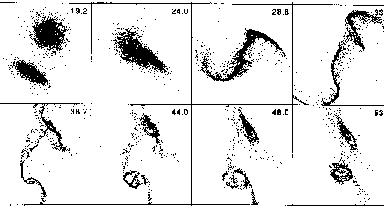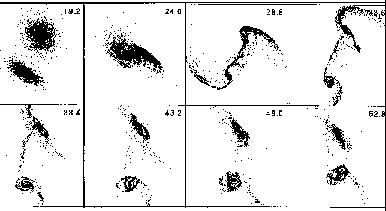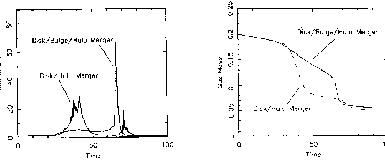


6.2. Gas flow and starburst/AGN triggering
In major mergers, where the two interacting galaxies are of comparable mass, strong non-axisymmetric forces are exerted on the gas. But contrary to what could be expected, the main torques responsible for the gas inflow are not directly due to the companion. The tidal perturbations destabilise the primary disk, and the non-axisymmetric structures generated in the primary disk (bars, spirals) are responsible for the torques. The self-gravity of the primary disk, and its consequent gravitational instabilities, play the fundamental role. The internal structure therefore takes over from the tidal perturbations on the outer parts. The gas is provided by the primary disk itself. Again it is not the gas accreted from the companion which is the main trigger for activity, until the final merger of course. This is why the first parameter determining the characteristics of the merger event is the initial mass distribution in the two interacting galaxies (Mihos & Hernquist 1996). The mass ratio between the bulge and the disk is a more fundamental parameter than the geometry of the encounter (see fig 20 and 21).

|
Figure 20. Simulations of the gas and young stellar components in the merger of disk/halo models. Time is indicated in units of 12 Myr (from Mihos & Hernquist 1996). |
The central bulge stabilises the disk with respect to external perturbations. If the bulge is sufficiently massive, the apparition of a strong bar is delayed until the final merging stages, and so is the gas inflow, and the consequent star-formation activity. But the starburst can then be stronger. When the primary disk is of very late type, without any bulge, the gravitational instability settles in as soon as the beginning of the interaction, there is then a continuous activity during the interaction, but at the end the starburst is less violent, since most of the gas has been progressively consumed before (see fig 22).

|
Figure 21. Same as fig 20 for the merger of disk/bulge/halo models, |
The effects of the geometry are more visible on the direct manifestations of the tidal interaction, i.e. on the tails and debris. For the galaxy experiencing a retrograde collision, no extended tidal tail is formed. There is no resonance effects in the target galaxy disk, and less violent material perturbations; a transient leading tidal arm is instead developped. There is however a tidally-induced two-arm density wave, and the subsequent torques produce gas inflow towards the center, as for the prograde encounter. During the interaction, it happens that the retrograde disk has more star formation than the prograde one, due to the larger gas content. For coplanar merger, the retrograde disk accretes a significant fraction of the gas from the prograde disk (Mihos & Hernquist 1996).
In the simulations, about 75% of the gas is consumed during the merger, whatever the internal structure of galaxies, or the geometry of the encounter (Mihos & Hernquist 1996). This is the most uncertain parameter, however. What is the fate of the rest of the gas? In general long tidal tails are entrained in the outer parts, especially in neutral hydrogen, since this is the most abundant component in external parts of galaxies. But most of the material of the tails is still bound to the system, and will rain down progressively onto the merger remnant (Hibbard 1995). Due to phase-wrapping process, it gives rise to shells and ripples. The HI fraction in the tails appear to increase as the merger enters in more advanced stages. This might be due to the transformation of HI to H2 in the central part. Also some of the gas is heated to the coronal phase (seen in X-rays).
During minor mergers, where the mass ratio between the two colliding galaxies is at least 3, the same features can be noticed: the first relevant parameter is the mass concentration in the galaxies before the interaction (Hernquist & Mihos 1995). The torques responsible for the gas mass inflow are exerted by the non-axisymmetric (essentially m = 2) potential developped in the disk. The torques are much stronger towards the center; the inflow time is of the order of the rotation time-scale at each radius.

|
Figure 22. left Evolution of the global star formation rate (relative to isolated disks) for the two models of fig 20 and 21; right Evolution of the total gas mass. |